RBSE Class 12 Biology Important Questions Chapter 1 Reproduction in Organisms
Rajasthan Board RBSE Class 12 Biology Important Questions Chapter 6 Molecular Basis of Inheritance Important Questions and Answers.
Rajasthan Board RBSE Solutions for Class 12 Biology in Hindi Medium & English Medium are part of RBSE Solutions for Class 12. Students can also read RBSE Class 12 Biology Important Questions for exam preparation. Students can also go through RBSE Class 12 Biology Notes to understand and remember the concepts easily. Browsing through manav janan class 12 in hindi that includes all questions presented in the textbook.
RBSE Class 12 Biology Chapter 1 Important Question Reproduction in Organisms
Multiple Choice Questions
Question 1.
Amoeba and yeast reproduce asexually by fission and budding respectively, because they are:
(a) microscopic organisms
(b) heterotrophic organisms
(c) unicellular organisms
(d) uninucleate organisms
Answer:
(c) unicellular organisms

Question 2.
Gemmules are found in:
(a) Hydra
(b) Sponges
(c) Nymphea
(d) Yeast
Answer:
(b) Sponges
Question 3.
Garlic is grown by:
(a) rhizome
(b) bulb
(c) bud
(d) runner
Answer:
(b) bulb
Question 4.
Vegetative propagation in ginger is carried out by:
(a) rhizome
(b) tubers
(c) bulbs
(d) roots
Answer:
(a) rhizome
Question 5.
Vegetative propagation in Bryophyllum mainly occurs by:
(a) bulbils
(b) rhizome
(c) leaf bud
(d) runner
Answer:
(c) leaf bud
Question 6.
Gametes are always:
(a) haploid
(b) diploid
(c) triploid
(d) haploid or diploid
Answer:
(a) haploid
Question 7.
The ‘eyes’ of the potato tuber are:
(a) root buds
(b) flower buds
(c) axillary buds
(d) shoot buds
Answer:
(c) axillary buds
Question 8.
Animals giving birth to young ones are:
(a) viviparous
(b) oviparous
(c) ovoviviparous
(d) both (a) and (b)
Answer:
(a) viviparous
Question 9.
Starfish regenerates an entire new starfish from a single arm by the process of:
(a) fragmentation
(b) fission
(c) spores
(d) budding
Answer:
(a) fragmentation
Question 10.
During pogenesis, each diploid oocyte produces:
(a) two functional eggs and two polar bodies
(b) four functional polar bodies
(c) four functional ova
(d) one functional egg and three polar bodies
Answer:
(c) four functional ova
Question 11.
The organism similar to parent can be obtained by:
(a) zygote
(b) gametes
(c) seeds
(d) binary fission
Answer:
(d) binary fission
Question 12.
Vegetative propagation takes place in Agave:
(a) by hybrid
(b) by stolon
(c) by rhizome
(d) by bulbils
Answer:
(d) by bulbils
Question 13.
Chromosomal set of zygote is:
(a) X
(b) 2X
(c) 3X
(d) 4X
Answer:
(b) 2X
Question 14.
If a plant fails to produce viable seeds, these could best be grown by:
(a) cutting
(b) micropropagation
(c) sexual method
(d) grafting
Answer:
(b) micropropagation
Question 15.
Which of the following is an oviparous animal?
(a) bat
(b) whale
(c) Amoeba
(d) penguin
Answer:
(d) penguin
Question 16.
Estrous cycle is characteristics of:
(a) mammals
(b) mammalian females
(c) human females
(d) mammalian females other than primates
Answer:
(a) mammals
Question 17.
Clones are:
(a) genetically similar to the parent plant
(b) plants raised from a single parent
(c) population of plants produced vegetatively
(d) all of the above
Answer:
(d) all of the above
Question 18.
External fertilization is found in which of the following?
(a) Reptiles
(b) Birds
(c) Amphibians
(d) Protozoans
Answer:
(c) Amphibians
Question 19.
Which of the following structures represent female gametophyte?
(a) Ovule
(b) Embryo
(c) Embryosac
(d) Endosperm
Answer:
(c) Embryosac
Question 20.
Conidia are produced by which of the following?
(a) Aspergillus
(b) Chlamydomonas
(c) Yeast
(d) Albugo
Answer:
(a) Aspergillus
Question 21.
The term ‘pistillate’ is used for:
(a) unisexual male flower
(b) unisexual female flower
(c) bisexual flower
(d) none of these
Answer:
(b) unisexual female flower
Question 22.
Zoospores are the reproductive units to carry asexual reproduction in
(a) Chlamydomonas
(b) Spirogyra
(c) Yeast
(d) Rhizopus
Answer:
(d) Rhizopus
Very Short Answer Type Questions
Question 1.
What is life span?
Answer:
The period between birth and the natural death of an organism is called its life span.
Question 2.
Define asexual reproduction.
Answer:
The mode of reproduction in which formation and fusion of gametes does not take place is called asexual reproduction.
Question 3.
What is sexual reproduction?
Answer:
The mode of reproduction which involves meiosis and fusion of gametes, is called sexual reproduction.
Question 4.
Give two examples which reproduce asexually by binary fission.
Answer:
Amoeba and Euglena.

Question 5.
Define clone.
Answer:
Morphologically and genetically similar individual produced as a result of asexual reproduction is called clone.
Question 6.
Give two examples which reproduce asexually by budding.
Answer:
- Yeast (a unicellular fungi).
- Hydra (a multicellular coelentrate).
Question 7.
What are vegetative propagules.
Answer:
In plants the units of vegetative propagation like tuber, bulb, rhizome etc., are called vegetative propagules.
Question 8.
On what factors does the type of reproduction adopted by an organism depend on?
Answer:
The organisms habitat, physiology and genetic make - up determine the type of reproduction adopted by it.
Question 9.
What is budding?
Answer:
Budding is a mode of asexual reproduction in which one or more outgrowths protrude out, which later attached from the parent body to grow into a new individual.
Question 10.
What are conidia?
Answer:
The asexual, non - motile spores produced externally/exogeneously in some fungi are called conidia.
Question 11.
Name two plants which reproduce by leaves.
Answer:
Bryophyllum and Begonia.
Question 12.
Define gemmules.
Answer:
Internal asexual reproductive units or buds in sponges are called gemmules.
Question 13.
What is gametogenesis?
Answer:
The process of gemete formation is called gametogenesis.
Question 14.
Mention the site where syngamy occurs in amphibians and reptiles.
Answer:
In amphibians syngamy occurs in water outside the body of organism. In reptiles, syngamy occurs inside the body of female.
Question 15.
Name the phase all organisms have to pass through before they can reproduce sexually.
Answer:
Juvenile phase.
Question 16.
Name the phenomenon and one bird where the female gamete directly develops into a new organism.
Answer:
This phenomenon is basically known as parthenogenesis. Example of one bird is turkey.
Question 17.
What are gametes?
Answer:
The reproductive haploid units which take part in syngamy are called gametes.
Question 18.
What are antherozoids?
Answer:
The male gamete or male reproductive unit is called antherozoid or spermatozoa.
Question 19.
What are the technical terms used for a bisexual condition?
Answer:
Homothallic and monoecious.
Question 20.
What do you mean by staminate and pistillate flower?
Answer:
The unisexual male flower bearing stamens is called staminate flower and the female flower bearing pistil is called pistillate flower.
Question 21.
Name two main events of pre - fertilization.
Answer:
- Gametogenesis
- Gamete transfer.
Question 22.
What are hermaphrodites?
Answer:
The animal or plant flower bearing both male and female sex organs are called hermaphrodite.
Question 23.
What is meant by meiocytes?
Answer:
In diploid organisms, gamete mother cell which undergoes meiosis to produce gamete is called meiocytes.
Question 24.
What is syngamy?
Answer:
The fusion of male and female gamete to form zygote is called syngamy.
Question 25.
What do you understand by oestrus cycle?
Answer:
The reproductive cycle in non - primates is called oestrus cycle.
Question 26.
What do you mean by menstrual cycle?
Answer:
The reproductive cycle in primates is called menstrual cycle.
Question 27.
What is paedogenesis?
Answer:
In some organisms, larvae may lay egg which develop parthenogenetically into a new generation of larvae this is called paedogenesis.
Question 28.
What are oviparous animals?
Answer:
The animals which lay eggs are called oviparous animals.
Question 29.
What are viviparous animals?
Answer:
The animals which give birth to young one are called viviparous animals.
Question 30.
What is embryogenesis?
Answer:
The development of embryo from zygote is called embryogenesis.
Question 31.
Meiosis is an essential event in the sexual life cycle of any organism. Give two reasons.
Answer:
Meiosis is an essential event in the sexual life cycle of any organism because:
- It is a source of genetic variations.
- It helps to conserve the chromosome number of species from generation to generation.
Question 32.
Explain the importance of syngamy and meiosis in a sexual life cycle of an organism.
Answer:
Syngamy helps to restore the diploid condition in the sexually reproducing organism by the formation of diploid zygote and thus ensuring the continuity of species. Meiosis helps in producing haploid gametes is sexually reproducing organism.
Question 33.
Write the number of chromosomes body cells of honeybee workers and drone have.
Or
A male honeybee has 16 chromosomes whereas its female has 32 chromosomes. Give one reason.
Answer:
In case of honeybees the male (drones) have 16 chromosomes and female (queen and workere) have 32 chromosomes, because of incomplete parthenogenesis. Fertilized diploid (2n) eggs give rise to females by sexual reproduction and Unfertilized haploid (n) eggs produce drones (male) by parthenogenesis.
Question 34.
At what stage does the meiosis occur in an organism exhibiting haplontic life cycle and mention the fate of the products thus produced.
Answer:
In organisms having haplontic life cycle, meiosis take place in diploid cell, i.e., zygote which divides to form haploid spores. These spores grow into haploid individuals.
Question 35.
What are the morphologically and genetically alike individuals?
Answer:
Clones.
Short Answer Type Question - I
Question 1.
What do you mean by binary fission. Give two examples of binary fission.
Answer:
When parental organism divides into two equal daughter cells during favourable conditions, it is called binary fission.
Examples:
- Bacteria
- Paramecium.
Question 2.
Give one example for each:
(a) Multiple fission
(b) Fragmentation
(c) Regeneration
(d) Budding
Answer:
(a) Multiple fission: Plasmodium
(b) Fragmentation: Spirogyra
(c) Regeneration: Planaria
(d) Budding: Hydra
Question 3.
Differentiate between primary fission and multiple fission.
Answer:
Difference between binary fission and multiple fission.
|
Binary Fission |
Multiple Fission |
|
1. In it, parental body divides into two daughter cells. |
1. In it parent body divides into many daughter cells. |
|
2. In this, no parental body part is left. |
2. In this residual cytoplasm is left. |
|
3. It takes place under favourable conditions. |
3. It takes place under unfavourable conditions. |
Question 4.
What is regeneration? Give suitable example.
Answer:
Regeneration is a process of asexual reproduction. For example, if a sponge is cut into many small pieces its each piece has regeneration power, hence reproduces into new sponge.
Question 5.
Give one example for each:
(a) Rhizome
(b) Bulbil
(c) Corm
(d) Tuber
Answer:
(a) Rhizome: Ginger
(b) Bulbil: Agave
(c) Corm: Colocasia
(d) Tuber: Potato
Question 6.
Give one example for each:
(a) Runner
(b) Sucker
(c) Offset
(d) Stalon
Answer:
(a) Runner: Doob grass (Cynodon)
(b) Sucker: Mint (Mentha)
(c) Offset: Water hyacinth (Eichornio)
(d) Stalon: Straberry (Fragaria)

Question 7.
What are spores? Name at least three types of spores.
Answer:
Spores are asexually reproducing bodies produced inside the sporengia. They germinate to produce new individuals. The different kinds, of spores are: zoospores, sporangiospores and chlamydospores.
Question 8.
How do roots take parts in vegetative propagation?
Answer:
Modified tuberous roots which passess bud, serve as natural method of vegetative propagation. These roots develop leafy shoots (called slips) above ground and adventitious roots underground.
Question 9.
What is artificial vegetative reproduction. Name two methods of artificial vegetative reproduction.
Answer:
Various methods of vegetative reproduction are man - made and are developed by plant growers for commercial production of crops. These are called artificial vegetative reproduction methods.
Examples:
- cutting
- grafting
- layering
- micropropagation.
Question 10.
Give the significance of asexual reproduction.
Answer:
The greatest advantage of asexual reproduction is that an organism biotype (the original organism) can be retained and multiplied indefinitely without any change or variation. The variations are normally excepted if organism Undergoes meiosis and syngamy.
Question 11.
Coconut palm is monoecious while date palm is dioecious. Why are they called so?
Answer:
In coconut palm, both male and female flowers develop on the same individual. This condition is called monoecious. In date palm, the male and female flowers develop on separate individuals. This condition is known as dioecious.
Question 12.
Differentiate between:
(a) Zoospore and Zygote
(b) Syngamy and Fertilization.
Answer:
(a) Zoospore is haploid and motile structure formed during asexual reproduction in lower plants and fungi while the zygote is a diploid and non - motile cell formed by the fusion of male and female gamete in sexual reproduction.
(b) Syngamy is actual fusion of male and female gametes whereas fertilization includes all the associated events that ultimately lead to syngamy.
Question 13.
The cell division involved in gamete formation is not of the same type in different organisms. Justify.
Answer:
The parents may be haploid or diploid but the gametes always have to be haploid. Diploid parents1 undergo meiosis to produce haploid gametes, whereas haploid parents undergo mitosis to produce haploid gametes.
Question 14.
The unicellular organisms which reproduce by binary fission are considered immortal. Justify.
Answer:
Asexual reproduction is common among unicellular organisms. Therefore in these organisms cell division is itself a mode of reproduction. In binary fission, the parent body divides into two halves and each rapidly grows into an adult. There are now remains of parental cell and parent cannot be said to have died. Hence, the unicellular organisms which undergo binary fission are called immortal.
Question 15.
What is parthenogensis? Give two examples from animals.
Answer:
The development of new individuals from unfertilized egg is called parthenogenesis. It is simpler, easier and wall as rapid mode of reproduction.
Examples: Honeybees and Some lizards.
Question 16.
A moss plant produces a large number of antherozoids but relatively only a few egg cells. Why?
Or
Why do moss plants produce very large number of male gametes? Provide one reason. What are these gametes called?
Answer:
Antherozoids are motile male gametophyles which have to swim on the water surface to fertilize the immotile female gametophyle i.e., egg. Since, during its transfer many antherozoids get destroyed, a large number of them are produced.
Question 17.
What are seasonal breeders? How do they differ from continuous breeders?
Answer:
Mammals that exhibit reproductive cycles only during favourable seasons in their reproductive phase are called seasonal breeders, e.g., deer. On the other hand, many mammals are reproductively active throughout their reproductive phase and hence are called continuous breeders, e.g., human.
Question 18.
What is external fertilization? Explain.
Answer:
In majority of aquatic organisms like algae, fishes and amphibians, fertilization takes place in external medium outside the body of organism. This type of fertilization is called external fertilization.
Question 19.
What is internal fertilization? Give examples.
Answer:
When male gamete and egg fuse inside the body of female the process is called internal fertilization. In many terrestrial organisms including fungi, reptiles, birds and mammals and in majority of plants (e.g., Bryophytes, pteridophytes, gymnosperms, angiosperms), internal fertilization occurs.
Question 20.
Differentiate between monoecious and dioecious plants. With example.
Answer:
Difference between Monoecious and Dioecious
|
Monoecious Plants |
Dioecious Plants |
|
1. When both male a nd female flowers are born on the same plant, they are called monoecious plants. |
1. When male and female flowers are present on different plants, they are called dioecious plants. |
|
2. Ex: Maize, Coconut, Cucurbits. |
2. Ex: Papaya, Datepalm. |
Question 21.
(i) Why do organisms like algae and fungi shifts from asexual mode of reproduction to sexual mode?
(ii) What is jurenile phase in organisms?
Answer:
(i) Organisms such as algae and fungi switch to sexual mode of reproduction during adverse conditions because asexual reproduction produces a large population that may not survive due to lack of resources. Sexual reproduction brings variations among the individuals, that might help the individuals to better adapt to the changed calamities and to survive. This ensures the continuity of species.
(ii) The period during which an organism grows to attain sexual maturity is called juvenile phase in animals. In plants, it is known as vegetative phase.
Question 22.
Why can an offspring produced by asexual reproduction be called as a clone? Give reason.
Answer:
In the process of asexual reproduction, only one parent is involved and there is no fusion of the male and female gamete. As a result, the offsprings so produced are morphologically and genetically similar to their parents. Therefore, these are called clones.
Question 23.
How bisexual and unisexual conditions in fungi and plants are denoted?
Answer:
In several fungi and plants, terms such as homothallic and monoecious are used to denote the bisexual condition and heterothallic and dioecious are the term used to describe unisexual condition.
Short Answer Type Question - II
Question 1.
Differentiate between juvenile phase and reproductive phase.
Answer:
Difference between Juvenile Phase and Reproductive Phase
|
Juvenile Phase |
Reproductive Phase |
|
1. It is an early phase of life cycle. |
1. It is middle phase of the life cycle. |
|
2. It is a period of rapid growth. |
2. Growth is either slow or absent in this phase. |
|
3. This phase is devoid of functional sex organs. |
3. It is characterised by the presence of functional sex organs. |
|
4. In this phase, shape and size change. |
4. It is a phase of permanent shape and size. |
|
5. Individuals in this phase are not active sexually. |
5. Individuals in this phase are sexually active |
Question 2.
Write basic features of asexual reproduction.
Answer:
Basic features of asexual reproduction:
- Asexual reproduction is uniparental as only one individual is involved.
- It does not involve formation and fusion of gametes.
- It does not needs formation of special reproductive organs.
- It invovles only mitotic divisions, so it is also called somatogenic reproduction.
- Daughter individuals are morphologically and genetically similar to their parents.
- It is rapid means of reproduction.
Question 3.
Write short note on Binary fission.
Answer:
It is a common method of asexual reproduction, in which parental organisms (cell) divides into two or more daughter individuals by simple or mitotic division. In this type of reproduction, the whole parental body is reproductive unit. On the basis of number of daughter cells produced, fission is of two types:
1. Binary Fission: The splitting of a parental cell into two equal daughter cells, each of which rapidly grows into an adult is called binary fission. It usually occurs during favorable conditions. It is commonly found in single - celled animals like bacteria and protozoans. It can be simple or irregular (in Amoeba), longitudinal (in Euglena), oblique or transverse (in Paramecium) depending on the plans of division.
Example 1.
Binary Fission in Euglena: In Euglena, longitudinal binary fission is found. In this karyokinesis takes place by Mitosis like Amoeba but cytokinosis takes place along longitudinal axis.
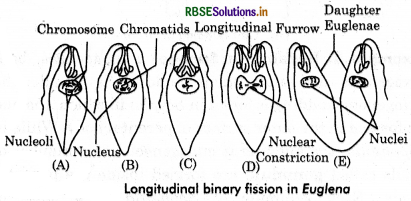
Example 2.
Binary Fission in Paramecium: In ciliates transverse binary fission is found. Paramecium has two nuclei, micro - nucleus and macronucleus. Macronucleus divides into two parts by amitosis and micronucleus divides into two by mitosis. The body of paramecium elongates alongwith division of both nuclei, by which oral groove makes two oral grooves on dividing paramecium also divides transversely between and two sets of nuclei, forming two daughter cells. Every daughter cell has one micro - nucleus and one macronucleus.
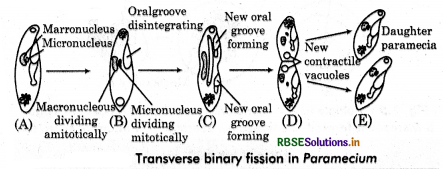
Example 3.
Binary Fission in Amoeba: In Amoeba binary fission may take place along any plane, its plane is always perpendicular to that of karyokinesis. It is called simple or irregular binary fission. In Amoeba chromosomes present in nucleus are replicated by mitotic division and later nucleus divides by furrowing. Then the cytoplasm gradually constricts between two seperating nuclei, ultimately forming identical equal sized daughter cells. Each daughter cell has a nucleus, the daughter cells grow to the size of the parent before dividing again.
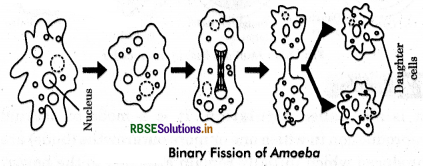
2. Multiple Fission: The splitting of a parent body (or cell) into numerous daughter cells, each of which grows into an adult, is called multiple fission. This type of fission is found in Amoeba, Plasmodium usually under unfavourable conditions.
Example: Multiple Fission in Plasmodium: In Plasmodium or malarial parasite, multiple fission occurs in schizogony (active adult phase) as well as in the sporogony (encysted zyogte phase). Cryptozoites of Plasmodium form many small offsprings by multiple fission, these are called merozoites in schizogony and sporozoites in sporogony.
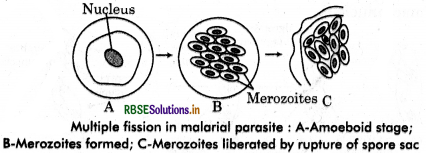
Example 2. Encystment and Multiple Fission in Amoeba:
In Amoeba multiple fission occurs during unfavourable conditions (lack of water, scarcity of food and extreme temperature). Amoeba withdraws its pseudopodia, secretes a thick cyst around and remains encysted during unfavourable period. This process is called encystment. Cyst also helps in perennation and dispersal. Under encysted condition, the nucleus of Amoeba divides by amitosis into many nuclei, called Amoebulae or Pseudopodiospore. On the return of favourable conditions, the cyst bursts to release many daughter Amoebae, which gradually grows into an adult.
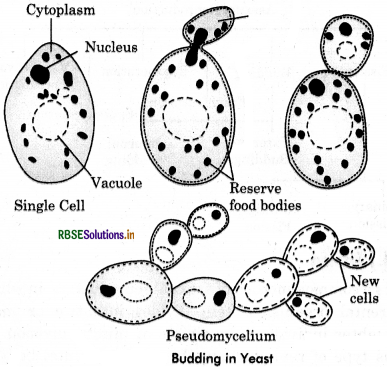
Question 4.
Write short note on multiple fission with a suitable example.
Or
Write short note on encystment in Amoeba.
Answer:
Multiple Fission: The splitting of a parent body (or cell) into numerous daughter cells, each of which grows into an adult, is called multiple fission. This type of fission is found in Amoeba, Plasmodium usually under unfavourable conditions.
Example: Multiple Fission in Plasmodium: In Plasmodium or malarial parasite, multiple fission occurs in schizogony (active adult phase) as well as in the sporogony (encysted zyogte phase). Cryptozoites of Plasmodium form many small offsprings by multiple fission, these are called merozoites in schizogony and sporozoites in sporogony.
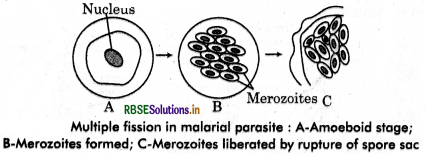
Example 2. Encystment and Multiple Fission in Amoeba:
In Amoeba multiple fission occurs during unfavourable conditions (lack of water, scarcity of food and extreme temperature). Amoeba withdraws its pseudopodia, secretes a thick cyst around and remains encysted during unfavourable period. This process is called encystment. Cyst also helps in perennation and dispersal. Under encysted condition, the nucleus of Amoeba divides by amitosis into many nuclei, called Amoebulae or Pseudopodiospore. On the return of favourable conditions, the cyst bursts to release many daughter Amoebae, which gradually grows into an adult.
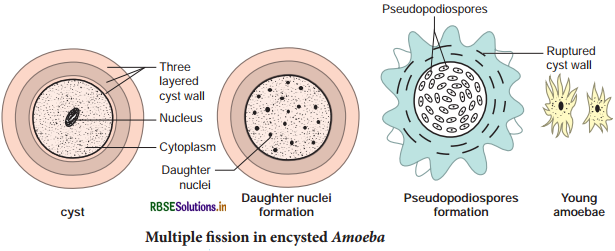
Question 5.
What is budding? Explain.
Or
Write the method of asexual reproduction by which yeast reproduce.
Answer:
It is also called torulation. It is a mode of asexual reproduction in which one or more outgrowths (buds) are produced which initially remain attached to the parent cell (or body) and eventually get separated from it to grow into a new individual.
Example 1. Budding in Yeast: Yeast is a unicellular fungus which reproduces by budding. Under favourable conditions, a small outgrowth arises from one or more than one places of yeast cell, this is called bud. Bud grows in size and nucleus of parent cell divides and one of the two daughter nuclei passes into the bud. Buds get separated from parent cell by constitution and can survive freely or remain attached with parent cell, so as to form a chain of cells called as pseudomycelium.
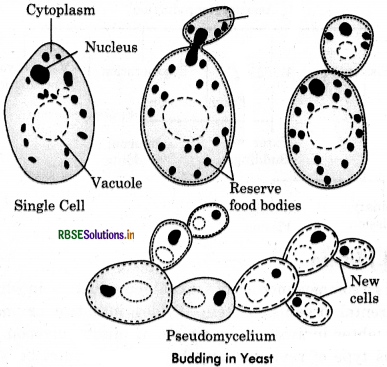
Question 6.
Write short note on regeneration with example.
Answer:
It is a mode of asexual reproduction in which the missing parts of an organism is repaired by proliferation of cells. This process is also called epimorphosis. But in some simple organisms regeneration involves formation of whole body from small body fragments. This process is called morphallaxis. Regeneration is seen in some animals such as Hydra, sponges, Planaria etc.
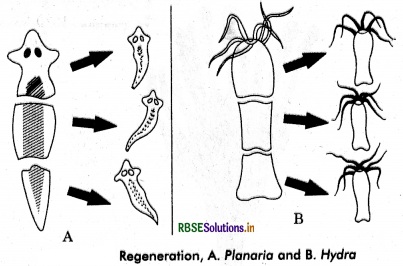
Question 7.
Write three advantages arid three disadvantages of vegetative propagation.
Answer:
Advantages of vegetative propagation:
- It is a cheaper, rapid and convenient method of growing plants.
- Disease - free plants can be produced by vegetative propagation.
- Some plants that do not form vible seeds are grown by vegetative propagation.
Disadvantage of vegetative propagation:
- It does not produce new varieties.
- Plants lose vigour when grown repeatedly.
- Undesirable characters persist in the species generation after generation.
Question 8.
What is a bulbil? Explain.
Answer:
Bulbil is a special type of multicellular structure and functions as an organ of vegetative reproduction. It is modified from either a vegetative bud or flower bud. In wild yalm (Dioscorea), the bulbil occurs as a single fleshy axillary bud. In Agave bulbils are found on inflorescence and are modified flowers. Bulbils when detached from the mother plant grow up into new plants, hence they are mainly modified for vegetative reproduction.

Question 9.
Give one example for each:
(i) Sporangiospore
(ii) Conidia
(iii) Hypnospores
(iv) Akinete
(v) Chlamydospore
(vi) Oidia.
Answer:
(i) Sporangiospore: Rhizopus
(ii) Conidia: Albugo
(iii) Hypnospore: Vaucheria
(iv) Akinete: Qedogonium
(v) Chlamydospore: Agaricus
(vi) Oidia: Coprinus.
Question 10.
Mention any two methods of grafting.
Answer:
Grafting:
It is the most common method of artifical vegetation propagation. It is carried out commonly in plants like Rose, Guava, Mango, Apple, Citrus, Pear, Plum etc. In this method, parts of two plants are joined in such a way that they grow like one plant. The root portion is taken from one plant is called the Stock, while the stem portion is taken from other plant and is called the Scion. The stock is always a plant which is resistant to diseases and has a deep root system for absorbing water and minerals. The scion is from a plant which yields better quality of fruits. There are following methods of grafting:
(1) Tongue Grafting or Whip GraftIng: In whip grafting, stock and scion are of the same diameter and are obliquely cut and placed end - to - end in such a way that the cambium of two are in intimate contect. The stem of stock is cut 8 - 12 inches above the ground. Leaves and buds are removed from this part. Now 4 - 10 inches long scion with all the buds intact is placed on the cut end of the stock and the joint is covered with a thin layer of clay or wax to check the evaporation and protect contamination due to entry of pathogens. Within a few days, the scion and the stock become the composite plant.
(2) Cleft Grafting or Wedge Grafting: In this type of grafting, a V - shaped notch is made in the stock. In this notch a twig of scion with wedge - shaped cut is inserted. Both the stock and scion are bound firmly with the help of thread or tap.
(3) Crown Grafting: In this more than one scions are grafted to one stock by wedge grafting.

Question 11.
Write short note on micropropagation.
Or
Mention the mode of vegetative propagation by which numerious plants are produced in a short time.
Answer:
Micropropagation: It is a modern method of vegetative propagation of plants. In this method thousands of plants can be grown from small tissue mass of parental plant. This method is based on tissue and cell culture technique.
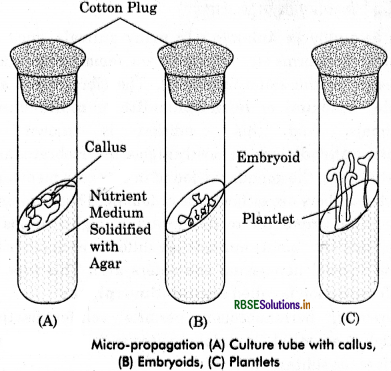
A callus is mass of undifferentiated parenchymatous cells. When a living plant tissue is placed in an artificial growing medium with other favourable conditions, callus is formed. Which later differentiates to produce a large number of plantlets. These plantlets are transferred to separate pots or nursery beds to obtain a large number of plants. Tissue culture technique is useful in obtaining virus free plants, disease free plants homozygous deploids and in commercial micropropagation of carnation, gladiolus, orchids, tomato, chrysanthemum and some other plants.
Importance of Vegetative Propagation
The following are some of the significant application of vegetative propagation:
- It is a cheaper, easier and rapid method of multiplication, for example many fruit trees usually require 4 - 5 years to bear the fruits when developed from seed. The plants developed by vegetative methods, however take only a year to bear fruits.
- The plants with no seeds or with long seed dormancy multiply by this method only.
- Plants like Banana, Grapes, Fig, Orange, Pineapple, Rose, Chrysanthemum, Tulip etc., do not produce viable seeds. These are grown only by vegetative propagation.
- The greatest advantage of vegetative propagation is that all the plants developed by these methods are genetically similar to parent plants. Such a genetically uniform population of plants raised from a single parent constitutes clone.
- Desirable characters of fruits and flowers can be maintained in plants grown by vegetative propagation.
- Disease free plants can be obtained by this method.
- Transgenic plants which may be sterile can be made to multiply.
- Grafting helps in combining good traits from two varities in a single plant.
Question 12.
Differentiate between oviparous and viviparous animals
Answer:
Differentiate between oviparous and viviparous animals:
|
Oviparous Animals |
Viviparous Animals |
|
1. Development of embryo takes place outside the female body. |
1. Development of embryo takes place inside the female body. |
|
2. Embryo develops inside the egg. |
2. Embryo develops inside the uterus of the female. |
|
3. Eggs store food as yolk and embryo |
3. Mother provides food to the growing embryo through placenta. |
|
4. Young one hatches out the egg. |
4. Young one in delivered by the mother. |
|
5. It occurs in egg - laying animals. |
5. It occurs in metatherian and eutherial mammals. |
Question 13.
Write importance of vegetative reproduction.
Answer:
Importance of Vegetative reproduction:
- Plants produced by vegetative propagation are genetically similar and constitute a uniform population called as clone.
- Plants that have reduced power of sexual reproduction, long dormat period of seed, poor viability can be multiplied by vegetative methods.
- Some fruit trees like banana, pineapple that do not produce viable seeds and dub grass which produces small quantity of seeds can be propagated by vegetative methods.
- It is a rapid and easier method of propagation.
- Good characters can be preserved by vegetative propagation.
- Vegetative Propagation can be used to develop Virus Free plants.
- Grafting helps in getting an economically important plant having useful characteristic of two different individuals in short time in a single plant.
Question 14.
The probability of fruit set in a self - pollinated bisexual flowers of a plant is far greater than a dioecious plant. Explain.
Answer:
In a dioecious plant a pollinating agent is needed to transfer pollen grains from one plant to other. In a self pollinated bisexual flower pollination is insured because it involves transfer of pollen grains from the anthers of a flower to the stigma of same flower. Therefore, probability of fruit formation are more in a self pollination bisexual flower.
Question 15.
It is possible to consider vagetative propagation observed in certain plant like Bryophyllum, Eichornia, ginger etc., as a type of asexual reproduction? Give three reasons.
Answer:
Vegetative propagation is a mode of asexual reproduction because:
- New plants are formed by any vegetative part of the parent plant by mitotic cell division.
- No reduction division, no haploid gamete formation.
- No pollination and fertilization.
Question 16.
Fertilization is not an obligatory event for fruit production in certain plants. Explain the statement.
Or
Mention the term for the phenomenon by which fruit can develop without fertilization. How it induced?
Answer:
Fruits can develop without fertilization it is called parthenocorpy. It can be induced either:
- By stimulus from pollination (without fertilization) or
- By hormones.
Question 17.
Differentiate between an annual and biennial plants, provide one example of each.
Answer:
|
Annual Plants |
Biennial Plants |
|
1. These plants complete their life cycle in one year. |
1. These plants complete their life cycle in two years. |
|
2. The vegetative and reproductive phase occur within a year only. |
2. Flowering occurs during second year, after a year of vegetative growth. |
|
3. Since these plants requireless time they are of low maintenance. |
3. Due to more time required in growing these plants require of high maintenance. |
|
4. Example: Cereals, lequmes. |
4. Example: Beetroot, radish. |
Long Answer Type Questions
Question 1.
What is reproduction? Name various types of asexual reproduction. Give a short discription of any two mode of asexual reproduction.
Or
Write short notes on the following:
(a) Fission
(b) Sporulation
Answer:
Production of offspring by a single parent without theformation and fusion of gametes is called asexual reproduction. The offsprings, produced from asexual reproduction receive all their genetic material from one parent. Therefore, these offsprings are identical morphologically and genetically and are called clones. Asexual reproduction is also known as Agamogenesis or Agamogeny.
Asexual reproduction occurs most commonly in unicellular organisms, such as Monerans and Protists, and in plants and certain animals. It is absent among the higher invertebrates and all vertebrates.
Types of Asexual Reproduction
Asexual reproduction occurs in different ways in different organisms. Some common types are discussed
below:
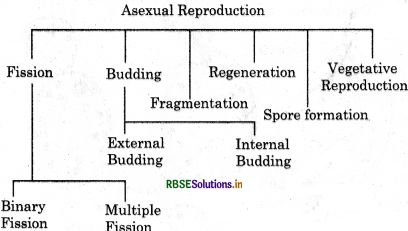
Fission:
It is a common method of asexual reproduction, in which parental organisms (cell) divides into two or more daughter individuals by simple or mitotic division. In this type of reproduction, the whole parental body is reproductive unit. On the basis of number of daughter cells produced, fission is of two types:
1. Binary Fission: The splitting of a parental cell into two equal daughter cells, each of which rapidly grows into an adult is called binary fission. It usually occurs during favorable conditions. It is commonly found in single - celled animals like bacteria and protozoans. It can be simple or irregular (in Amoeba), longitudinal (in Euglena), oblique or transverse (in Paramecium) depending on the plans of division.
Example 1.
Binary Fission in Euglena: In Euglena, longitudinal binary fission is found. In this karyokinesis takes place by Mitosis like Amoeba but cytokinosis takes place along longitudinal axis.
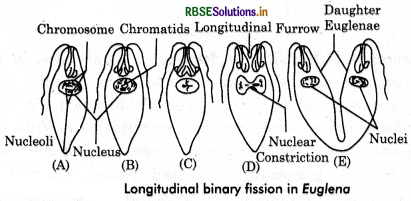
Example 2.
Binary Fission in Paramecium: In ciliates transverse binary fission is found. Paramecium has two nuclei, micro - nucleus and macronucleus. Macronucleus divides into two parts by amitosis and micronucleus divides into two by mitosis. The body of paramecium elongates alongwith division of both nuclei, by which oral groove makes two oral grooves on dividing paramecium also divides transversely between and two sets of nuclei, forming two daughter cells. Every daughter cell has one micro - nucleus and one macronucleus.
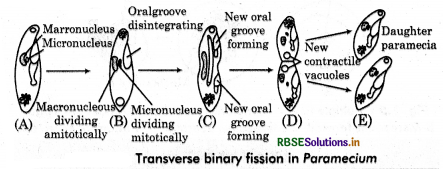
Example 3.
Binary Fission in Amoeba: In Amoeba binary fission may take place along any plane, its plane is always perpendicular to that of karyokinesis. It is called simple or irregular binary fission. In Amoeba chromosomes present in nucleus are replicated by mitotic division and later nucleus divides by furrowing. Then the cytoplasm gradually constricts between two seperating nuclei, ultimately forming identical equal sized daughter cells. Each daughter cell has a nucleus, the daughter cells grow to the size of the parent before dividing again.
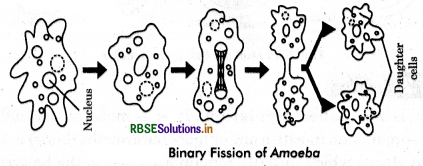
2. Multiple Fission: The splitting of a parent body (or cell) into numerous daughter cells, each of which grows into an adult, is called multiple fission. This type of fission is found in Amoeba, Plasmodium usually under unfavourable conditions.
Example: Multiple Fission in Plasmodium: In Plasmodium or malarial parasite, multiple fission occurs in schizogony (active adult phase) as well as in the sporogony (encysted zyogte phase). Cryptozoites of Plasmodium form many small offsprings by multiple fission, these are called merozoites in schizogony and sporozoites in sporogony.

Example 2. Encystment and Multiple Fission in Amoeba:
In Amoeba multiple fission occurs during unfavourable conditions (lack of water, scarcity of food and extreme temperature). Amoeba withdraws its pseudopodia, secretes a thick cyst around and remains encysted during unfavourable period. This process is called encystment. Cyst also helps in perennation and dispersal. Under encysted condition, the nucleus of Amoeba divides by amitosis into many nuclei, called Amoebulae or Pseudopodiospore. On the return of favourable conditions, the cyst bursts to release many daughter Amoebae, which gradually grows into an adult.
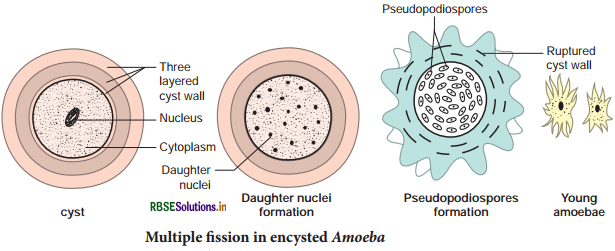
Spores are haploid asexual reproductive structures that develop into haploid organisms under favourable conditions but can survive when conditions are unfavourable by forming resistant covering. Spores may be thin - walled or thick - walled, motile or non - motile. Spore formation is found in algae, fungi, bryophytes and pteridophytes. These are following types:
- Zoospores
- Sporanglosepores
- Conidia
- Aplanospores
- Hypnospores
- Akinete
- Chiamydospores
- Oidia
Question 2.
Write short notes on:
(a) Budding
(b) Fragmentation
Answer:
(a) Budding:
It is also called torulation. It is a mode of asexual reproduction in which one or more outgrowths (buds) are produced which initially remain attached to the parent cell (or body) and eventually get separated from it to grow into a new individual.
Example 1. Buddlng In Yeast: Yeast is a unicellular fungus which reproduces by budding. Under favourable conditions, a small outgrowth arises from one or more than one places of yeast cell, this is called bud. Bud grows in size and nucleus of parent cell divides and one of the two daughter nuclei passes into the bud. Buds get separated from parent cell by constitution and can survive freely or remain attached with parent cell, so as to form a chain of cells called aspseudomycelium.
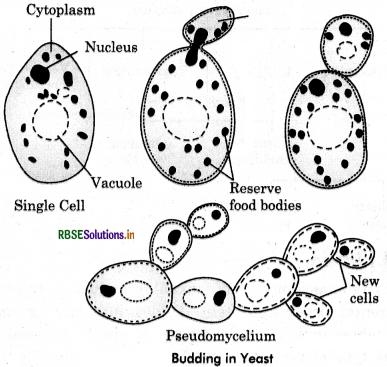
Example 2. BuddIng In Hydra: In Hydra exogenous budding is found under favourable conditions. In Hydra, bud arises from the body near the gastric part as an outgrowth. It enlarges and develops tentacles. The fully formed bud separates from parent body and starts an independent life.

Example 3. Budding in Sponges: In sponges, both exogenous and endogenous budding is found. The exogenous budding is found in Scypha in which, the bud is formed in the outer surface of parental body. While in SpongiUa, the budding is endogeneous as a number of buds called gemmule are formed inside the parental body. Each gem mule of Spongilla is a mass of undifferentiated cells. These are called archeocytes,
surrounded by a protective coat of spicules. Gemmule helps in perennation and dispersal, During favourable condition, archeocytes come out of gemmule through micropyle and form a new sponge.
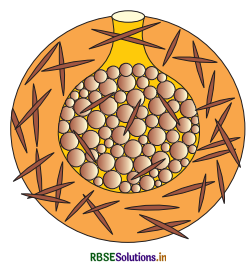
(b) Fragmentation:
It is a mode of asexual reproduction in which the parental body breaks into two or more fragments and each fragment grows into a new individual. Fragmentation is an accidental process. Fragmentation is seen in algae (Spirogyra), Fungi (Rhizopus), some bryophytes (Riccia and Marche ntia) and some pteridophytes (Selaginelia).
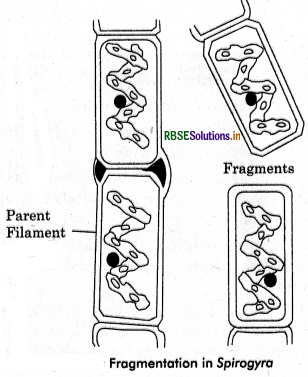
Question 3.
What do you understand by vegetative propagation? Name various mode of vegetative propagation.
Answer:
Usually, the term “vegetative propagation” is applied for vegetative reproduction in plants. Some plants are able to multiply by vegetative methods, which involves the production of new plants without the act of fertilization. Vegetative propagation is the formation of new plants from vegetative parts of the parent plant like root, stem, rhizoids, leaf or bud.
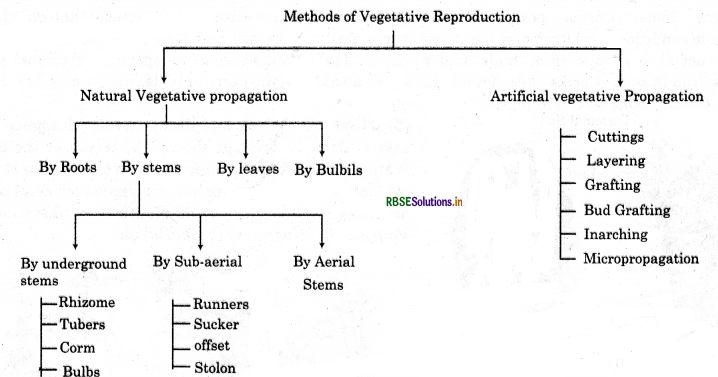
Methods of Vegetative Propagation: Vegetative propagation is of two main types:
A. Natural vegetative propagation:
Natural vegetative propagation occurs when an axillary bud from root, shoot or any other part of plants, grows into a lateral shoot and develops its own roots. There are following methods of natural vegetative propagation:
(a) By Roots: The roots of some plants have adventitious buds on them, which give birth to new plants. This type of roots are found in Dahlia, Sweet potato, Sissoo, Topioca etc. The buds present on the root grow into leafy shoots, which are called slips. Each slip gives rise to a new plant. The roots of Sissoo, Populus, Guava, Albizzia lebbek etc., develop adventitious buds. These put out shoots and produce new plants.
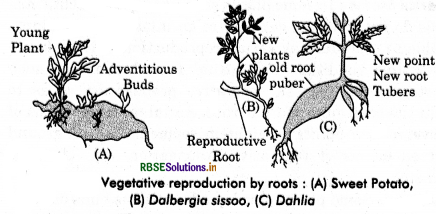
(b) By Stems: The stems of some plants give birth to new plant. The propagation of plants by stem is of two types:
1. By underground Stem: In some plants, normally, during unfavourable conditions, the aerial part of modified underground stems dries and on the return of favourable conditions, these underground parts help invegetative propagation producing new aerial shoot.
B. Artificial vegetative propagation:
Several methods at vegetative propagation of plants are man - made and develop by plant growers and horticulturists for commercial production of plants. These methods are called artificial vegetative methods. These also include natural methods of propagation such
as use of potato tubers for growing potato crops commercially. Similarly, bulbs of onion, corm of banana, rhizome of ginger and turmeric, runners of mint etc., are artificially used for commercial production of these crops. Some artificial methods of vegetative propagation are given below:
1. Cutting: The small piece of any plant organ (root, stem or leaf) used for propagation is called cutting. Root cuttings are used to propagate Tamarind and Citron. Leaf cuttings are used to propagate Begonia, Bryophyllum and Sansevieria. But stem cuttings are most commonly used for artificial vegetative propagation. For this purpose, about 20 - 30 cm long pieces of healthy stem are planted in the natural position in the soil for proper sprouting.
Factors such as age of the parent plant, diameter and length of the cuttings, season and the type of plants are taken into consideration for the propagation of a particular plant species. Some times the stem cuttings are treated with rooting hormone (Indol Butyric Acid; IBA) for proper development of roots. Grapes, rose, sugarcane, coleus, Bougainvillea, Duranta, Henna (Lawson ja), carnation
etc., are generally propagated by stem cuttings.
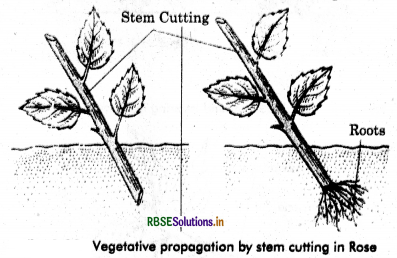
2. Layering: The development of roots on a stem while the stem is still attached to the parent plant is called layering. It is done in two ways:
- Mound layering
- Air layering or Gootee.
Question 4.
Give a brief discription of natural vegetative propagation.
Or
How some parts like root, stems, leaves etc. take part in natural vegetative propagation?
Answer:
Reproduction of new plants from the portion of the vegetative parts of a plant is very common and is called vegetative reproduction. Stems, roots, leaves and even buds are variously modified to suit this requirement. This is called natural vegetative reproduction.
The new plants formed by vegetative propagation are genetically similar to the parents.
Natural Method: In natural methods, a portion of the plant gets detached from the body of the mother plant and grows into an independent plant. The parts may be stem, root, leaf or even flower.
1. The underground modification of stem, like rhizome, (in ginger), tuber (potato), bulb (onion) and corm (zamikand) are provided with buds which develop into a new plant and are therefore used to carry out vegetative propagation of the plant in the field. Plants with subaerial modification such as Pistia (offset) and Chrysanthemum (sucker) are also used for vegetative propagation.
2. Similarly, tuberous roots (Asparagus and sweet potato) can also be used for propagation as these roots have adventitious buds which grow into a new plant.
3. Sometimes even leaves contribute to propagation of plants for example, leaves of Bryophyllum and Kalanchoe have buds on the margin and these buds grow into small plantlets. When detached from the mother plant they grow into independent plants.
4. In plants like Agave and Oxalis multicellular bodies called bulbils develop from flower - buds. These are called bulbils which when fall on the ground, grow into new plant.
Question 5.
Write short notes on the following:
(a) Cutting
(b) Layering
Answer:
(a) Cutting:
Cutting: The small piece of any plant organ (root, stem or leaf) used for propagation is called cutting. Root cuttings are used to propagate Tamarind and Citron. Leaf cuttings are used to propagate Begonia, Bryophyllum and Sansevieria. But stem cuttings are most commonly used for artificial vegetative propagation. For this purpose, about 20 - 30 cm long pieces of healthy stem are planted in the natural position in the soil for proper sprouting.
Factors such as age of the parent plant, diameter and length of the cuttings, season and the type of plants are taken into consideration for the propagation of a particular plant species. Some times the stem cuttings are treated with rooting hormone (Indol Butyric Acid; IBA) for proper development of roots. Grapes, rose, sugarcane, coleus, Bougainvillea, Duranta, Henna (Lawson la), carnation etc., are generally propagated by stem cuttings.

(b) Layering:
Layering: The development of roots on a stem while the stem is still attached to the parent plant is called layering. It is done in two ways:
1. Mound Layering: It is the most common method of propagating herbaceous plants. In this method, the lower branch of stem is bent down and partially defoliated. An injury is made in the defoliated portion. The injured portion is covered with a thin layer of moist clay soil with rooting hormone in such a way that the growing tip of the branch remain above the soil surface, After a few days the pegged portion produces adventitious roots. The rooted branch is then cut, separated from parent plant and grown as a new plant. This type of layering can be done in Grape vine, Jasmine, Strawberry, Clematis, Cherry etc.
2. Air Layering or Gootee: This method is used in plant like Guava, Litchi, Lemon, Orange etc., having hard and thick branches which cannot be bent and also employed in case of shrubs and trees which do not possess branches near the ground. In this method, a ring of bark is removed or a slit at an upward angle is made at the base of an aerial branch.
This portion is then covered with moist grafting clay having rooting hormone and wrapped with a polythene sheet. The wrapped portion is called gootee. The girdled portion of the branch inside the gootee develops roots within a period of one or two months. After rooting the branch is cut and planted in the soil after removing the polythene. This method is commonly used in vegetative propagation of Pomegranate, Orange, Lokat, Lemon, Litchi etc.
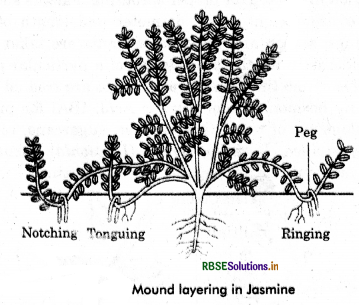
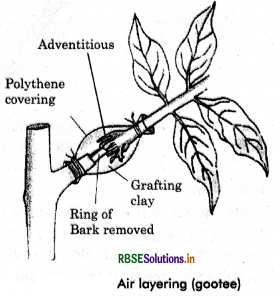
Question 6.
What is grafting. Write about various methods of grafting with diagram.
Answer:
Grafting: It is the most common method of artificial vegetative propagation. It is carried out commonly in plants like Rose, Guava, Mango, Apple, Citrus, Pear, Plum etc. In this method, parts of two plants are joined in such a way that they grow like one plant. The root portion is taken from one plant is called the Stock, while the stem portion is taken from other plant and is called the Scion. The stock is always a plant which is resistant to diseases and has a deep root system for absorbing water and minerals. The scion is from a plant which yields better quality of fruits. There are following methods of grafting:
1. Tongue Grafting or Whip Grafting: In whip grafting, stock and scion are of the same diameter and are obliquely cut and placed end-to-end in such a way that the cambium of two are in intimate contect. The stem of stock is cut 8 - 12 inches above the ground. Leaves and buds are removed from this part. Now 4 - 10 inches long scion with all the buds intact is placed on the cut end of the stock and the joint is covered with a thin layer of clay or wax to check the evaporation and protect contamination due to entry of pathogens. Within a few days, the scion and the stock become the composite plant.
2. Cleft Grafting or Wedge Grafting: In this type of grafting, a V - shaped notch is made in the stock. In this notch a twig of scion with wedge-shaped cut is inserted. Both the stock and scion are bound firmly with the help of thread or tap.
3. Crown Grafting: In this more than one scions are grafted to one stock by wedge grafting.
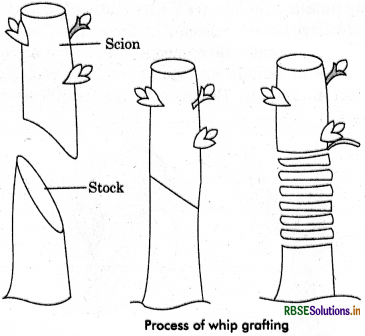
Question 7.
Write short notes on the following:
(a) Bud grafting
(b) Inarching
Answer:
(a) Bud grafting:
Bud Grafting (Budding): In bud grafting, a single bud along with a certain portion of the living tissue of the scion is taken. This bud is now inserted in the incision made in the stock. After insertion the bud is tied together with stock. Budding is usually done during rainy season so that bud may not dry up and die. Budding is generally done in rose plant.
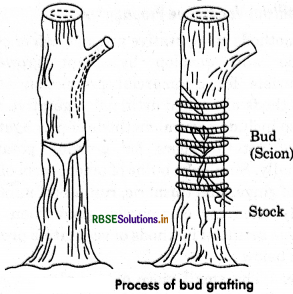
(b) Inarching:
Inarching: In this method, low quality plants are converted into high quality plants. Stock is taken from low quality plant and scion from high quality plant. Bark of both plants is removed from one side at same hight. Now the stems of both the plants tied together at the place of removed bark. It is wrapped by grafting clay. After sometime both scion and stock get fixed to each other.
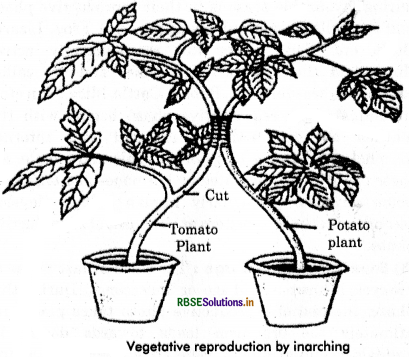
Question 8.
What is sexual reproduction. Give the basic features of sexual reproduction.
Answer:
Sexual reproduction is the production of offsprings by the formation and fusion of specialized male and female cells, called gamets. The gametes are formed either in the same individual or in different individuals of the opposite sex. These are haploid and provide the link between two generations. These gametes fuse to form the diploid zygote which develop into new organism.
Sexual reproduction is an elaborate, complex and slow process as compared to asexual reproduction. Because of the fusion of male and female gametes, sexual reproduction results in offspring that are not identical to the parents or to each other. This is the result of genetic recombination of inherited traits of the two parents.
Basic Features of Sexual Reproduction:
- It generally involves two parents (male and female) so also called biparental, except Taenia, Fasciola. In case of plants, various plants hear both male and female reproductive structures in same individual.
- It involves formation and fusion of gametes or gametic nuclei.
- It involves meiosis during gametogenesis and mitosis during development of zygote.
- In sexual reproduction, the male and female gametes fuse to form zygote, which form embryo and finally develops into a new organism.
- Sexual reproduction plays an important role in evolution because offsprings are genetically different from the parent as variations appear due to new combinations of gene during crossing over in sexual reproduction.

Question 9.
Write short notes on the following:
(a) Juvenile or vegetative phase.
(b) Reproductive phase.
(c) Senescence or old age.
Answer:
Pattern of Sexual Reproduction:
Although, the mode of sexual reproduction in diverse organisms (i.e., plants, animals and fungi) shows that though these organisms differ in anatomy, external morphology and physiology, the pattern of their sexual reproduction is almost the same.
1. Juvenile or Vegetative Phase: All the organisms grow to a certain maturity in their life before they start reproducing sexually. The period of growth between their birth upto their reproductive maturity is called the juvenile phase. In plants. the period of growth between seed germination up to initiation of flowering is called vegetative phase. This phase varies from organisms to organisms.
2. Reproductive Phase: The later part, when the organisms start reproducing sexually is called reproductive phase. In higher plants (seed plants), the flowering phase is called as their reproductive phase. In animals the end of juvenile phase is indicated by appearance of certain morphological and physiological changes prior to reproductive phase. This phase also shows a great variation among different organisms.
In animals, the beginning of reproductive phase starts along with various morphological and physiological changes. In organisms, particularly in human beings, the reproductive organs develop and get mature during this phase. There are two main reproductive patterns found in mammals : Menstrual cycle - This cycle is observed in primate mammals like Monkeys, Apes and Humans. Oestrous Cycle - This cycle is observed in nonprimate mammals like Cows, Sheeps, Rats, Deer, Dogs, Tigers etc. Furthermore, animals, particularly those living in natural wild conditions exhibit such cyclic changes only during favourable seasons in their reproductive phase and are called seasonal breeders, e.g., Frog, Lizard, Birds etc.
Some other are reproductively active throughout their reproductive phase and are called continuous breeders. e.g., Rabbit, Cattle, Mice, Man etc. In animals, the reproductive phase begins with the marked changes both in external and internal morphology and physiology of the male and female. All these changes are regulated by hormones and enzymes. Some animals, particularly human beings, develop secondary sexual characters at the onset of reproductive phase.
3. Senescence or Old age: The third or last phase of life cycle is knwn as ‘old age’ or ‘senescence’. During this phase, the end of reproductive phase takes place and utimately the organism leads towards death. In annuals, biennial plants, vegetative, reproductive and senescent phases can be clearly seen. Whereas in the case of trees which are perennials it is very difficult to clearly define uhases. Senescence carries finally to death.
Question 10.
Write an essay on sexuality in organisms.
Answer:
1. Sexuality In Animals: In many animals, such as Hydra, flatworms etc., both male and female gonads are present in the same individual. Therefore, these are called bisexual or hermaphrodite or monoecious animals. And this condition is known as Hermaphroditism. In mostly higher invertebrates and vertebrates, the gonads are found in separate members, such members are either male or female. These animals are called unisexual or dioecious. In higher animals, the male and female animals are differ to each other by some special non - sexual characters also.
This type of differentiation is called sexual dimorphism. Moreover, hermaphroism permits self - fertilisation which is essential for endoparasites such as tapeworm, as it leads solitary life. In some bisexual animals, both male and female sex organs mature at different time to avoid self fertilization. They are either protogynous (female organs - ovaries maturing first) or protrandrous (male organs - testes maturing first).

2. Sexuality in Plants: Like animals, plants also have male and female reproductive organs but their shape and size is different from animals. The reproductive organs of plants are present in flower. Morphologicálly ‘the flower is a modified shoot’ in which sexual reproduction process occurs. Sexual reproduction in plants involves the fusion of gametes from two different individuals. But this is not always so, because plants may be either bisexual or perfect i.e., with both male and female reproductive organs in the same plant as in pea, rice, wheat, mango etc. or unisexual or imperfect with male and female reproductive structures on different plants as in papaya, datepaim etc.
In flowering plants, unisexual flower bearing stamens is called staminate and female flowers bearing pisti is called pistillate. Both male and female flowers may be present on the same plant (monoecious) or on separate plants (dioecious). Cucurbits and coconut are monoecious plants, and papaya and date-palm are dioecious plants. In lower plants like algae, fungi, bryophytes and some other plants, the terms homothallic and monoecious are used to denote bisexual condition and heterothallic and dioecious for unisexual condition.
Question 11.
Name the events of sexual reproduction. Mention pre - fertilization events in brief.
Answer:
All sexually reproducing organisms follow a regular sequence of events characterised by fusion of male and female gametes fertilisation, formation of zygote and embryogenesis. These sequential events may be grouped into following three distinct phases:
- Pre - fertilization events
- Syngamy or Fertilization
- Post Fertilization
Pre - fertilisation events are gametogenesis and gamete transfer. Post fertilisation events are embryogenesis and syngamy.
Gametogenesis is a biological process by which dipioid or haploid precursor cells undergo cell division and differentiation to form mature haploid gametes.
Gamete transfer involves the transfer of gamete from male to female. In plants, it is transferred by fertilisation while in animais t takes place by copulation.
Syngarny is the fusion of male and female gametes.
Embryogenesis is the process of development of the embryo.
Question 12.
What do you understand by syngamy? Write short notes on internal fertilization and external fertilization.
Answer:
The fusion of male gamete with female gamete is called syngainy. The fusion of their nuclei to form zygote is called Fertilization. However, the terms syngamy and fertilization are frequently used interchangeably. It is the most crucial and vital event of sexual reproduction.
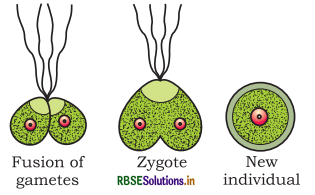
There are two types of gametic fusion namely external fertilization and internal fertilization.
1. External Fertlllzation: When fertilization occurs in external medium outside the body of organism called external fertiliz&iåon. In majority of Algae, Fishes and Amphibians, external fertilisation is found. These organisms release large number of male and female gametes into the water to enhance the chance of fertilization. In this situation organisms may or may not make a physical contact but the two must shed their gametes at the same time and place in large number. A major disadvantage of external fertilization is that the offspring are vulnerable to predators and are under constant threat to their survival upto adulthood.
2. InternaI Fertilization: When the fusion of male gamete with female gamete inside the body of female organism, the process is called external fertilization. In many terrestrial organisms including fungi, reptiles, birds and mammals and in majority of plants (e.g., Bryophyta, Pteridophyta, Gymnosperms and Angiosperms) internal fertilization occurs. In such organisms egg is produced by the ovary inside the body of females (in animals) or female sex organ (in plants). The male gamete which is usually motile, moves towards egg for fertilization. Organisms which favour internal fertilization also produce a large number of male gametes (sperms or pollens) in comparision to number of eggs.
Question 13.
Write an essay on post fertilization events.
Or
Write short notes on the following:
(a) Formation of Zygote
(b) Embryogenesis.
Answer:
All the events that occur in sexual reproduction after fertilization are called post - fertilization events. These include formation of zygote and embryogenesis.
(a) FormatIon of Zygote : Fusion of two haploid (n) gametes results in the formation of single diploid zygote (2n). In organisms with external fertilization, zygote is formed usually in water (outside the body) as in algae bony fishes, frogs etc., whereas in organisms exhibiting internal fertilization the zygote develops inside the body of organism.
In many algae and fungi, zygote secretes a thick wall and forms a perennating spore called zygospore. It germinates during the next growing season and undergoes meiosis and forms four haploid bodies. This leads to haplontic life cycle. In most animals zygote does not take. It divides by mitosis forming a diploid embryo and then the complete diploid organism.
This represents diplentic life cycle. In most plants, zygote germinates to form an embryo and then the diploid embryo and then the complete diploid organism. This represents diplentic life cycle. In most plants, zygote germinates to form an embryo and then the diploid sporophyte. The sporophyte has sporangia where meiosis takes place to form haploid spores. Thase grow into haploid gametophytes. Gametes are produced in the gametophyte. It leads to a diplo - haplontic life cycle.
(b) Embryogenesls : The process of the development of embryo to form the zygote is called embryogenesis. Initially the zygote undergoes mitosis which is a simple cell division and after a few divisions it enters into another process called cell differentiation. The zygote now is transformed into a mass of cells which is called developing embryo. Cell differentiation results in formation of specialized tissues, and organs in the developing foetus.
Question 14.
What are viviparous and oviparous animals. Give a brief discription of embryogenesis in flowering plants.
Answer:
Ovipary and Vivipary
In animals the development of the zygote takes place either inside the body of female parent or outside. On this basis, the animals are grouped into twò categories:
- Oviparous animals : These animals lay fertilized or unfertilized egg. Reptiles and birds are oiparous animals, lay fertilized eggs in a safe place in the environment. Their eggs are covered by a hard calcareous shell. After passing a variable incubation period, the young ones hatch out from the eggs.
- Viviparous animals : These animals give birth to youngones. Most mammals including humans are viviparous. The zygote develops into young one inside the body of the female in these animals. Because of better embryonal profection and care, chance of survival of the young ones are greater in viviparous animals.
Question 15.
Write on essay on parthenogenesis.
Answer:
Parthenogenesis is a modification of sexual reproduction in which an egg develops into a complete offspring without fertilization. It is monoparental. Parthenogenesis is common in Rotifers, Aphids, Bees and Crustaceans. It also occurs in a few vertebrates (some lizards and
certain birds).
Parthenogenesis is of two main types : Natural and artificial.
1. Natural Parthenogenesis: it occurs regularly in life cycle of some animals. It may be complete, incomplete or paedogenetic.
1. Complete (Obligatory) Parthenogenesis: It is found in some rotifers and a few vertebrates. These animals reproduce only by parthenogenesis. There are no males at all. Hence, there is no biparental sexual reproduction. Females develop exclusively by parthenogenesis in Lacerta sexicola americana (a lizard) and Typhlina brahmina (The small Indian snake), show complete parthenogenesis.
2. Incomplete (Cyclic) Parthenogenesis: In this sexual generation alternates with parthenogenetic generation. For instance, (a) In honey bees, fertilized eggs give rise to queens and workers (both are females) with diploid cells. Unfertilized eggs (ova) develop into drones (males) with haploid cells. Spermatogenesis in drones is peculiar as it lacks meiosis. (b) Some species of wasps produce alternately a parthenogenetic generation and one which develops from fertilized eggs. (c) In turkey, bird about 40% males are produced by parthenogenesis whereas 60% males and all females develop from fertilized eggs.
3. Paedogenetic Parthenogenesis: In certain insects, larvae lay eggs which develop parthenogenetically into a new generation of larvae. This is called paedogenetic parthenogenesis.
2. Artificial Parthenogenesis : In many sexually reproducing animals the eggs can be activated by artificial methods to starts the development without fertilization. It is called artificial parthenogenesis. Eggs of sea urchin can be made to develop successfully, if treated with weak salt solution, weak organic acids, electric shocks or by shaking in sea water or by pricking the eggs with glass needle.
Advantages of Parthenogenesis
- Parthenogenesis is a simpler and easier means of reproduction.
- This avoids the wastage of germplasm as sperms and ova.
- The offsprings are exactly similar to parents.
- It permits establishment of triploid and aneuploid chromosomal combinations.
- It is the means of sex determination in some animals such as in honey bees. Thus, it support chromosomal theory of sex determination.
- The offsprings are a kin to parent and therefore, parthenogenesis eliminates variety in population.
Disadvantages of Parthenogenesis:
It stops the chance of new combinations of genes and thus, avoids selection in the population. This results in lack of adaptability followed by extinction or return to sexuality.

- RBSE Class 12 Biology Notes Chapter 16 पर्यावरण के मुद्दे
- RBSE Class 12 Biology Notes Chapter 15 जैव-विविधता एवं संरक्षण
- RBSE Class 12 Biology Notes Chapter 14 पारितंत्र
- RBSE Class 12 Biology Notes Chapter 13 जीव और समष्टियाँ
- RBSE Class 12 Biology Notes Chapter 12 जैव प्रौद्योगिकी एवं उसके उपयोग
- RBSE Class 12 Biology Notes Chapter 11 जैव प्रौद्योगिकी-सिद्धांत व प्रक्रम
- RBSE Class 12 Biology Notes Chapter 10 मानव कल्याण में सूक्ष्मजीव
- RBSE Class 12 Biology Notes Chapter 9 खाद्य उत्पादन में वृद्धि की कार्यनीति
- RBSE Class 12 Biology Notes Chapter 8 मानव स्वास्थ्य तथा रोग
- RBSE Class 12 Biology Notes Chapter 7 विकास
- RBSE Class 12 Biology Notes Chapter 6 वंशागति के आणविक आधार